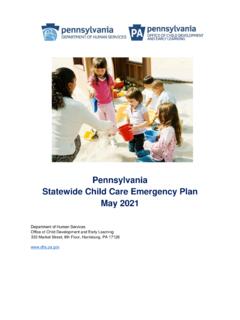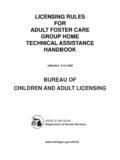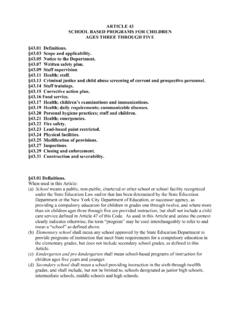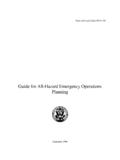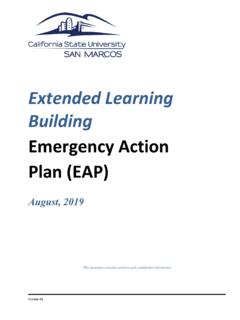Transcription of Federal Emergency Management Policy Changes After …
1 CRS Report for CongressPrepared for Members and Committees of Congress Federal Emergency Management Policy Changes After Hurricane Katrina: A Summary of Statutory Provisions Keith Bea, Coordinator Section Research Manager March 6, 2007 Congressional Research Service7-5700 RL33729 Federal Emergency Management Policy Changes After Hurricane Katrina Congressional Research Service Summary Reports issued by committees of the 109th Congress, the White House, Federal offices of Inspector General, and the Government Accountability Office (GAO), among others, concluded that the losses caused by Hurricane Katrina were due, in part, to deficiencies such as questionable leadership decisions and capabilities, organizational failures, overwhelmed preparation and communication systems, and inadequate statutory authorities.
2 As a result, the 109th Congress revised Federal Emergency Management policies vested in the President; reorganized the Federal Emergency Management Agency (FEMA); and enhanced and clarified the mission, functions, and authorities of the agency, as well as those of its parent, the Department of Homeland Security (DHS). Six statutes enacted by the 109th Congress are notable in that they contain Changes that apply to future Federal Emergency Management actions. These public laws include the following: Title VI of 109-295 ( 5441), the Post-Katrina Emergency Management Reform Act of 2006, referred to in this report as the Post-Katrina Act; Sections of 109-347 ( 4954), the Security and Accountability for Every Port Act of 2005, known as the SAFE Port Act; 109-308 ( 3858), the Pets Evacuation and Transportation Standards Act of 2006; 109-63 ( 3650), the Federal Judiciary Emergency Special Sessions Act of 2005; 109-67 ( 3668), the Student Grant Hurricane and Disaster Relief Act; and Sections of 109-364 ( 5122), the John Warner National Defense Authorization Act for Fiscal Year 2007.
3 Most of these statutes contain relatively few Changes to Federal authorities related to emergencies and disasters. The Post-Katrina Act, however, contains many Changes that will have long-term consequences for FEMA and other Federal entities. That statute reorganizes FEMA, expands its statutory authority, and imposes new conditions and requirements on the operations of the agency. The Administration will implement these new authorities through the FY2008 appropriations legislation. The oversight plans of committees with jurisdiction indicate that Members of the 110th Congress will evaluate the steps taken by the leadership of FEMA to carry out the expanded legislative mandate.
4 In addition, Members will continue to debate legislation pertaining to the recovery of Gulf Coast states. For example, 1144 would waive disaster assistance cost share requirements for the states affected by the hurricanes. This report will be updated as developments warrant. Federal Emergency Management Policy Changes After Hurricane Katrina Congressional Research Service Contents Overview .. 1 Report Limitations .. 2 Report Organization .. 2 Emergency Management Organizations and Functions .. 3 Background .. 3 The New FEMA: Organization and Mission .. 5 The New FEMA Components .. 5 The New FEMA Missions (Generally) .. 6 Administrative Responsibilities .. 7 Disaster Response.
5 8 Disaster Recovery .. 8 National Disaster Housing Strategy .. 9 Continuity of Government and Operations .. 9 FEMA Sub-Units and Missions .. 10 Other DHS Entities ..11 Effective Date for Organizational Changes .. 13 Emergency Management Leadership .. 13 Background .. 13 Leadership Positions Under the Post-Katrina 14 Abolished Positions .. 17 New Positions .. 17 Changes to Existing Positions .. 18 Qualifications .. 19 Personnel and 20 Background .. 20 Strategic Human Capital 21 Career 22 Recruitment .. 22 Retention .. 23 Vacancy Rate Reports .. 23 Department Rotation 24 Surge Capacity Force .. 25 National Preparedness .. 25 Background .. 25 National Preparedness 27 National Planning 27 Target Capabilities and Preparedness 28 Preparedness Federal Evacuations.
6 29 Education and Training .. 30 Background .. 30 Education and Training Institutions .. 31 Homeland Security Training and Exercise Programs .. 31 Homeland Security Education Program .. 33 Federal Emergency Management Policy Changes After Hurricane Katrina Congressional Research Service Equipment and Training Standards .. 34 Stafford Act assistance Amendments .. 34 Background .. 34 Expedited Federal assistance .. 35 Aid to Individuals .. 35 Housing assistance ..36 Public assistance .. 37 Definitions ..37 Grants and Loans .. 38 Pilot 38 Mutual 38 Hazard Mitigation ..39 Administrative Changes .. 39 Pets and Service Animals .. 40 110th Congress Stafford Act 40 1144.
7 40 41 Background .. 41 Advance 41 Subcontracting Tiers ..41 Using Local Firms, Organizations, and 41 Noncompetitive Contracts .. 42 Contractor Registry ..42 Oversight and Accountability ..42 Background .. 42 Oversight and Accountability of Federal Disaster Expenditures .. 43 Fraud, Waste, and Abuse Controls .. 43 Fraud Prevention Training Programs .. 43 Report and Guideline Development 44 Background .. 44 Requirements .. 44 FEMA Requirement .. 44 DHS Secretary Requirements .. 44 FEMA Administrator Requirements .. 45 Federal Communications Commission 47 Other Provisions .. 47 Background .. 47 Effective Date .. 47 Authorizations .. 47 National Weather Service.
8 48 Education 48 Federal 48 National Guard .. 48 Firearms Seizure .. 49 Acronyms .. 49 Federal Emergency Management Policy Changes After Hurricane Katrina Congressional Research Service Tables Table 1. Statutory Changes to Emergency Management Leadership Positions Under 15 Contacts Author Contact Information ..51 Federal Emergency Management Policy Changes After Hurricane Katrina Congressional Research Service 1 Overview Hurricane Katrina struck Florida and the Gulf Coast states in the last days of August 2005, followed within weeks by Hurricanes Rita and Wilma. These disasters will long be remembered for disrupting families, changing and ending lives, and forcing Americans to rethink vulnerability and risk assumptions.
9 In addition to these impacts, the hurricanes served as catalysts for significant Changes in Federal Policy and the organization of responsible Federal entities, notably within the Department of Homeland Security (DHS). Most of those Changes were included in Title VI of the DHS appropriations legislation for Among other provisions, Title VI, officially titled the Post-Katrina Emergency Management Reform Act of 2006 (hereafter referred to as the Post-Katrina Act), established new leadership positions and position requirements within the Federal Emergency Management Agency (FEMA), brought new missions into FEMA and restored some that had previously been removed, and enhanced the agency s authority by directing the FEMA Administrator to undertake a broad range of activities before and After disasters occur.
10 The Post-Katrina Act contains provisions that set out new law, amend the Homeland Security Act (HSA),2 and modify the Robert T. Stafford Disaster Relief and Emergency assistance Act (the Stafford Act).3 In addition to the Post-Katrina Act, Congress enacted five other statutes that have long-term implications for the administration of Federal Emergency These include: Sections of 109-347 ( 4954), the Security and Accountability for Every Port Act of 2005, known as the SAFE Port Act; 109-308 ( 3858), the Pets Evacuation and Transportation Standards Act of 2006; 109-63 ( 3650), the Federal Judiciary Emergency Special Sessions Act of 2005; 109-67 ( 3668), the Student Grant Hurricane and Disaster Relief Act; and Sections of 109-364 ( 5122), the John Warner National Defense Authorization Act for Fiscal Year 2007.










